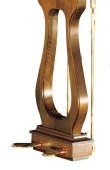Una corda
una corda (abbreviation: uc , from the Italian: “one string”, sometimes also una chorda ) means two things: a piano with only one string assigned to each key; and a technical playing instruction for the grand piano that prompts you to step on the left pedal. This results in a mechanical change in position of the mechanism , the hammers only strike the fringe strings (ideally only one string per key, una corda) and thus generate quieter sounds. The playing instruction tre corde (abbreviation: tc ) indicates to let go of the pedal again.
The mechanical change that when the left pedal on a piano in wing construction takes place, is the cause of the term una corda . Custom-made pianos with one string per key today are called Una Corda pianos and go back to the early days of the piano, when it evolved from the harpsichord (with one string per key). It was volume reasons that led to the installation of several strings per key. The piano maker David Klavins has specialized in recreating this historical concept.
Una corda pedal on the grand piano
The left pedal of the grand piano moves the mechanics together with the keyboard and the hammers to the side by a few millimeters (usually to the right, for Ibach and some other brands to the left). The power is transmitted via a brass rod that protrudes vertically upwards and a metal or wooden bracket. In the treble and the middle register, the hammers now only strike two out of three strings of a string choir, in the middle bass range only one of two strings ( una corda ) - the fullness of sound is reduced, a quieter tone is produced. During the shift, other, mostly softer parts of the hammer head felt hit the strings. This makes the tones quieter and softer even in the single-string double bass area.
Due to mostly three-string references from the middle position and the attack of two of the three strings with the left pedal depressed, due corde instead of una corda should be spoken more precisely today . In the past, fortepianos often had only two strings per tone; only one string was struck with the left pedal, hence una corda .
Because the keys are shifted when the left pedal is pressed on the grand piano, the term shift is often used instead of una corda .
Left pedal at the piano
On the piano, stepping on the left pedal means that the hammers are brought closer to the strings by means of the hinged rest bar, approx. Half way, so that the acceleration path of the hammers is shortened so that less energy can be introduced into the hammer movement and the result is played quieter. Una corda is also a term for the piano, but is technically not implemented in the linguistic sense. Occasionally - more correctly - is also spoken of the "quiet pedal". In rare cases, high-quality grand pianos also have a fourth pedal on the left, which performs the same function of shortening the hammer path as on the piano ( Fazioli ). Since these functions are independent of each other, they can also be combined.
Playing feel and tone color
While the action feels unchanged when you press the left pedal on the grand piano, the piano action becomes smoother and less precise because no force is transmitted to the hammer during the first part of the key stroke. In addition, the timbre changes on the grand piano due to the displacement of the hammer heads and the resonance of the strings that are not directly struck, which is neither the case on the piano.
